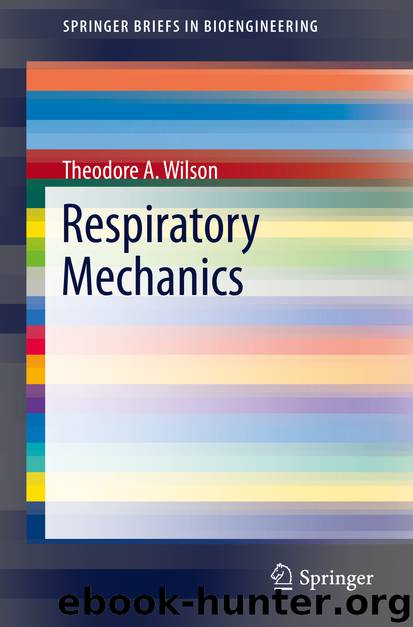Respiratory Mechanics by Theodore A. Wilson

Author:Theodore A. Wilson
Language: eng
Format: epub
Publisher: Springer International Publishing, Cham
2.3.1 Respiratory Effect
The muscles of the diaphragm shorten by 30–35 % with passive lung inflation from FRC to TLC [19, 21, 23]. For a 24 kg dog, therefore, . Muscle mass is 95 g [24], and the maximum respiratory effect of the diaphragm is . The proportionality between level of activation and mechanical advantage, described above, applies within each muscle group, but not across groups. In the dog, the mechanical advantage of the diaphragm is twice that of the parasternals, but the level of activation of the diaphragm during spontaneous breathing is always less than maximum [25] whereas the level of activation of the parasternals during vigorous inspiratory efforts approaches 100 %. Thus, it appears that the mass of the diaphragm has been set by other functions.
Download
This site does not store any files on its server. We only index and link to content provided by other sites. Please contact the content providers to delete copyright contents if any and email us, we'll remove relevant links or contents immediately.
Sapiens: A Brief History of Humankind by Yuval Noah Harari(13983)
The Tidewater Tales by John Barth(12391)
Mastermind: How to Think Like Sherlock Holmes by Maria Konnikova(6935)
Do No Harm Stories of Life, Death and Brain Surgery by Henry Marsh(6683)
The Thirst by Nesbo Jo(6432)
Why We Sleep: Unlocking the Power of Sleep and Dreams by Matthew Walker(6349)
Life 3.0: Being Human in the Age of Artificial Intelligence by Tegmark Max(5182)
Sapiens by Yuval Noah Harari(5118)
The Longevity Diet by Valter Longo(4856)
The Body: A Guide for Occupants by Bill Bryson(4578)
The Rules Do Not Apply by Ariel Levy(4520)
The Immortal Life of Henrietta Lacks by Rebecca Skloot(4248)
Why We Sleep by Matthew Walker(4190)
Animal Frequency by Melissa Alvarez(4148)
Yoga Anatomy by Kaminoff Leslie(4100)
The Hacking of the American Mind by Robert H. Lustig(4080)
All Creatures Great and Small by James Herriot(3980)
Barron's AP Biology by Goldberg M.S. Deborah T(3941)
Double Down (Diary of a Wimpy Kid Book 11) by Jeff Kinney(3922)
